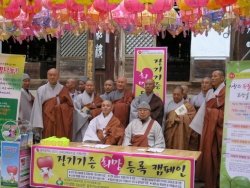Difference between revisions of "Hwaeomsa Temple (화엄사)"
m (Text replace - "Right" to "Right") |
|||
| Line 1: | Line 1: | ||
[[File:P4038675.JPG|thumb|250px|]] | [[File:P4038675.JPG|thumb|250px|]] | ||
| − | Situated on the southwest corner of Mt. Jirisan, Hwaeomsa Temple is one of the 10 most famous temples in [[Korea]]. It was constructed in the fifth year of King Jinheung’s reign (544) during the Silla Era, but was burnt down during Japanese Invasion, Jeongyujaeran in 1592. Including the main building Daeungjeon, the temple was rebuilt during the Joseon Period. | + | Situated on the [[southwest]] corner of [[Mt. Jirisan]], [[Hwaeomsa Temple]] is one of the 10 most famous [[temples]] in [[Korea]]. It was [[constructed]] in the fifth year of [[King]] Jinheung’s reign (544) during the [[Silla]] {{Wiki|Era}}, but was burnt down during [[Japanese]] Invasion, Jeongyujaeran in 1592. Including the main building Daeungjeon, the [[temple]] was rebuilt during the [[Joseon Period]]. |
| − | The [[Path]] to the temple lies along the valley named Hwaeomsa Temple Valley. It also takes you to Nogodan Plateau of Mt. Jirisan. With [[Korean]] traditional straw-roofed houses and a water mill, you can find a cozy place named Siuidongsan, which means the Hill of [[Poetry]], to take a rest at your Right on the [[Way]] to the temple. | + | The [[Path]] to the [[temple]] lies along the valley named [[Hwaeomsa Temple]] Valley. It also takes you to Nogodan Plateau of [[Mt. Jirisan]]. With [[Korean]] [[traditional]] straw-roofed houses and a [[water]] mill, you can find a cozy place named Siuidongsan, which means the Hill of [[Poetry]], to take a rest at your Right on the [[Way]] to the [[temple]]. |
| − | Beyond this area is the main gate of Hwaeomsa Temple, Iljumun Gate, and a long stonewall. Entering the main gate, you can find Geumgangmun Gate and the stairs going up to Bojeru. At the top of the stairs, there are the main building Daeungjeon and Gakhwangjeon Pavilion. There are also Seo-ocheung [[Pagoda]] (west-five-story [[Pagoda]]) and Dongocheung [[Pagoda]] (east-five-story [[Pagoda]]) at each side of the front yard. In front of Gakhwangjeon Pavilion is the largest [[Light]] made of stone in [[Korea]]. In addition, there are many national treasures here including the Sasaja Samcheung (3-story) Stone [[Pagoda]], which is situated at the hill called Hyodae. The main building Daeungjeon and Bojeru is magnificent and graceful. Keeping its original [[Beauty]], Hwa-eomsa Temple makes beautiful scenery with the nature around it. | + | Beyond this area is the main gate of [[Hwaeomsa Temple]], [[Iljumun]] Gate, and a long stonewall. Entering the main gate, you can find Geumgangmun Gate and the stairs going up to Bojeru. At the top of the stairs, there are the main building Daeungjeon and Gakhwangjeon Pavilion. There are also Seo-ocheung [[Pagoda]] (west-five-story [[Pagoda]]) and Dongocheung [[Pagoda]] (east-five-story [[Pagoda]]) at each side of the front yard. In front of Gakhwangjeon Pavilion is the largest [[Light]] made of stone in [[Korea]]. In addition, there are many [[national treasures]] here including the Sasaja Samcheung (3-story) Stone [[Pagoda]], which is situated at the hill called Hyodae. The main building Daeungjeon and Bojeru is magnificent and graceful. Keeping its original [[Beauty]], Hwa-eomsa [[Temple]] makes beautiful scenery with the [[nature]] around it. |
{{R}} | {{R}} | ||
[http://english.visitkorea.or.kr/enu/SI/SI_EN_3_1_1_1.jsp?cid=264128 english.visitkorea.or.kr] | [http://english.visitkorea.or.kr/enu/SI/SI_EN_3_1_1_1.jsp?cid=264128 english.visitkorea.or.kr] | ||
Latest revision as of 06:36, 23 March 2015
Situated on the southwest corner of Mt. Jirisan, Hwaeomsa Temple is one of the 10 most famous temples in Korea. It was constructed in the fifth year of King Jinheung’s reign (544) during the Silla Era, but was burnt down during Japanese Invasion, Jeongyujaeran in 1592. Including the main building Daeungjeon, the temple was rebuilt during the Joseon Period. The Path to the temple lies along the valley named Hwaeomsa Temple Valley. It also takes you to Nogodan Plateau of Mt. Jirisan. With Korean traditional straw-roofed houses and a water mill, you can find a cozy place named Siuidongsan, which means the Hill of Poetry, to take a rest at your Right on the Way to the temple. Beyond this area is the main gate of Hwaeomsa Temple, Iljumun Gate, and a long stonewall. Entering the main gate, you can find Geumgangmun Gate and the stairs going up to Bojeru. At the top of the stairs, there are the main building Daeungjeon and Gakhwangjeon Pavilion. There are also Seo-ocheung Pagoda (west-five-story Pagoda) and Dongocheung Pagoda (east-five-story Pagoda) at each side of the front yard. In front of Gakhwangjeon Pavilion is the largest Light made of stone in Korea. In addition, there are many national treasures here including the Sasaja Samcheung (3-story) Stone Pagoda, which is situated at the hill called Hyodae. The main building Daeungjeon and Bojeru is magnificent and graceful. Keeping its original Beauty, Hwa-eomsa Temple makes beautiful scenery with the nature around it.
